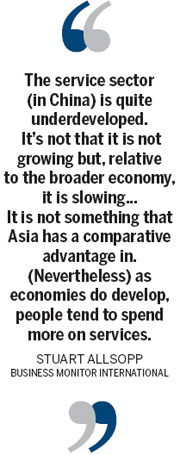Ready to go
Updated: 2013-10-25 09:56
By Alfred Romann (China Daily Europe)
|
|||||||||||
|
The 2013 China International Financial Exhibition was held in Beijing last month. Wu Changqing / for China Daily |
ASEAN advantage
The services sector accounts for between 40 and 50 percent of the GDP of most ASEAN countries, according to a paper published in July by the ASEAN Secretariat. The service sector is the fastest growing in the region.
Expanding the trade in services among the 10 members of ASEAN - Brunei, Cambodia, Indonesia, Laos, Malaysia, Myanmar, the Philippines, Singapore, Thailand and Vietnam- is one of the key points of the upcoming ASEAN Economic Community, due to come into being in 2015.
By 2008, about half of ASEAN FDI flows, about $33.5 billion, went to services. Conversely, the export of services out of ASEAN to the world market has grown steadily, rising from just $68 billion in 2000 to $153 billion in 2007.
 |
By 2010, ASEAN countries removed most of the restrictions for investment in four priority service sectors of air transport, e-commerce, healthcare and tourism. By the end of this year, restrictions on the trade of logistics services should be lifted and all other services should be mostly open by 2015.
Increasing integration between ASEAN and more advanced economies such as China, Japan and South Korea will help this process along. China, in particular, is undergoing this shift toward more demand-led production of services at the same time as most ASEAN economies.
On the positive side, this will mean that economies in the region will continue to benefit from continuing growth and reform in China. The creation of the Shanghai free trade zone, which puts emphasis on the trade in services, should help this process.
On the negative side, a slowdown in China would probably spread to economies across ASEAN almost instantaneously.
"The prospects of the APEC region are increasingly linked to China's outlook," ratings agency Moody's Investors Service said in a recent report. Any slowdown in China has an immediate impact on economies in the region, particularly those in ASEAN that are increasingly integrated.
"In recent years, China's impact on the regional economy has been deeply profound and the stabilization in the country's growth cycle could help cushion domestic demand weakness across Asia," says Rahul Ghosh, of Business Monitor International in Singapore.
Even though services account for most employment in China and that growth is visible, the service sector remains relatively underdeveloped compared with the sector in economies such as the US or Europe, where services account for about 75 percent and 60 percent of GDP.
Chinese Premier Li Keqiang has been vocal in advocating the growth of services. Speaking in May, he said increasing the availability and quality of the country's service industries "will help unleash huge potential in domestic demand, and thus offer firm support for stable economic growth and structural optimization".
"China will further open up the service industry and pilot free trade experimental zones to tap development," he said.
For China Daily
( China Daily European Weekly 10/25/2013 page1)
Today's Top News
Mythbuster dispels fictions about China
Forum urges stableChina-Japan ties
NSA spying hurts US diplomacy
Carrier rocket sent to launch base for moon landing
Requirements cut for business startups
Study shows PM1 most harmful
Cold snap to sweep NE, N China
Paper apologizes for reporter's untrue stories
Hot Topics
Lunar probe , China growth forecasts, Emission rules get tougher, China seen through 'colored lens', International board,
Editor's Picks

|

|

|

|

|

|






